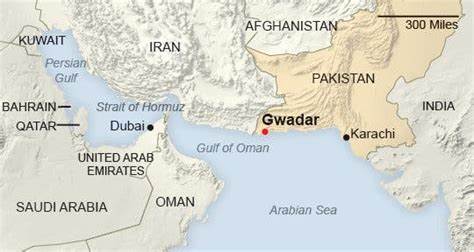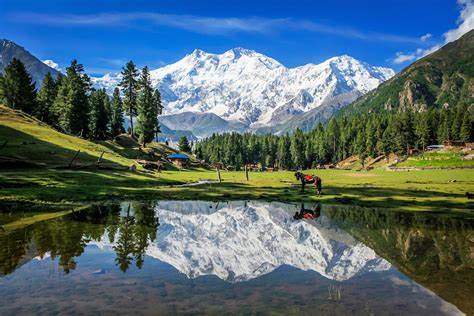Explore the rich history of Gwadar, from its ancient connections to prominent conquerors to its modern-day significance as a strategic port city. Learn about the historical events, foreign invasions, and local rulers that shaped Gwadar’s past. Discover the role of Begum Waqar Nisa Noon in securing Gwadar for Pakistan and the untapped potential of this coastal region in driving economic growth.

Gwadar, Gwat-Dar means the door or passage of the air, is only 120 kilometres from the city of Turbat and only 170 kilometres from Chabahar, the port of the Sistan province of Iran, in the west. If the weather is clear, the lights of Muscat city can be seen from any high hill of Pushkan.
From 1783 to 1958, Gwadar was the property of Oman due to the generosity of the Khan of Qalat. Much earlier than the 18th century, we find references to the Makran era in the narratives of the Prophet Davood (peace be upon him) in the Middle Ages. The invasion of Cyrus and Samira and then following them, the famous adventures of Alexander the Great are mentioned in detail. Ferdowsi in his well-known Shahnama describes this area as a battleground between Turanian and Iranian kings. Makran, of which Gwadar is an integral part, was a part of the Iranian conquests during the reign of the Iranian King Kayos. In between, Makran temporarily came under Afrasiab of Turanis. It was retrieved by Khusrau after five fierce wars, and he settled there for a year.
After these famous conquerors, this region was under the control of the armies of Alexander the Great through Lehrasp, Gestasp, Bahman, Huma and Darab. His arrival to Makran in 325 BC and passing through here is part of the stubborn impressions of history. Most historians agree that the hardships Alexander the Great had to go through in the whole of Asia, cannot be compared to the sufferings he faced in this region. It was very excruciating. The great vanquisher of the world with his remaining army, passing along the north coast of the Hangul river and behind the mountain range of the Makran coast, reached the coast between Pesni and Kalmat and through Gwadar turned towards Gwadar and Bampur. Then, with the help of small boats, he hauled onto the banks of the river Indus.
Selivkos Nika Tor himself came to Makran, and while crossing the Indus River, he confronted his former king Chandra Rigupta of Magadh. Defeated in this contest, he was forced to retreat and surrender Makran along with several other provinces to Raja Chandra Gupta in a humiliating treaty.
Makran and Gwadar remained out of sight for several centuries thereafter. In the 5th century AD, it emerged again as an Indian-occupied territory. When Sher Mah, the ruler of India, married his daughter to Bahrampur (404-427 AD), the fourteenth ruler of the Sassanid Empire, and gave her the territories of Sindh and Makran as dowry. For the next two centuries, this area remained under the rule of the Sassanids. Then, for a short period, it came under the Brahmin kingdom of Sindh. After that, Sindh and Makran came under the influence of the Arabs and their adventures. With their arrival, this area became part of the Arab conquests. When the conquest of Sindh was completed by Muhammad bin Qasim, Makran was administratively merged with Prasand. In the 10th century AD, there was an Arab named Isa bin Madan who was the ruler here and lived in Kech. Shortly after the departure of the Prophet Muhammad (peace be upon him), from the era of the Rashideen Caliphs until the time of the Banu Umayyad governments, this region somehow remained under the control of the Arabs and was constantly under the influence of revolts, independence warriors and rebellions. It also suffered from constant agitation. This region and its inhabitants did not take in foreign domination for long. Sovereignty and an independent attitude are in their blood. They always clutch their traditions and culture. We have taken a brief overview of the history of Makran and its heart Gwadar in the distant past. Now it is better to give a brief glimpse into the recent past because its history is so appealing and has such an endless series of events that it requires many books to author.
The foreign invaders and explorers always continued to assert their sovereignty over this area, sometimes for a longer period and sometimes temporarily. The Velma, Seljuq, Ghaznavid and Mongols all attempted to conquer the region but were forced back by fate and its inhabitants. There is no clear evidence that Makran was ever formally part of the empire under the influence of the Mughal emperors of Delhi or was permanently subject to them. The Portuguese also ventured towards India. They attempted to grab several places along the coast of Makran at the beginning of the 16th century. But they couldn’t go inside much. The two cannons taken from them in Gwadar and Pisni testify to their failure. The Portuguese in 1901 had burnt Pasni and Gwadar to revoke their defeat.
By the twelfth century AD, the local Maliks became the owners of these areas. In the 19th century, Makran was temporarily a part of the Safari kingdom of Sistan, one of those countries, when this area came under Bilidis. The period of their elevation is from 1613 to 1740. After the collapse of the Bilidis, Gachki evolved as the mukhtar and owner of the area. Then there was a series of skirmishes and coercion between several powerful clans, including the Khans of Kalat and the Mirs.
When the first Afghan war was launched, the British started scrutinising this region. Major Leach sent Haji Abdul Nabi to visit this area in 1838-39. Major Goldsmid surveyed the region in 1861 and 1862 to lay the Indo-European telegraph line and took responsibility for this work. In 1871, the Iranians seized the throne of Ibrahim Khan, the ruler of Bampur. But the British Government of India ceased the progression of the Persians according to the will of the Khan of Kalat.
Diplomatic activities and reconciliation between the martial coalitions and the delimitation of their territories remained the focus of this war of nerves. This was met with success finally, and eventually, the parties accepted the border proposed by Captain Lovett. In the same period, the rulers of Muscat also emerged in Makran and Gwadar. From October 25, 1871, to September 24, 1872, a stretched nervous conflict continued between the British, Iranian and regional administrators and commanders.
For the next several years, Makran suffered from internal conflicts and frequent disruptions. During this period, British administrators and authorities were continuously active in settling or escalating disputes and their influence and jurisdiction amplified. Sir Robert Sandeman gained dominion among the local chieftains and powerful clans skillfully. His measures greatly aided the British Government. Lord Curzon, Viceroy, came to Pisni in 1903 and visited Makran. The British authorities posted their Political Agents and Commandants of the Makran Naval Corps in this area. The British cunningly completed their oppression in a very persuasive manner under the guise of executing the rule of Khan of Qalat. The British influence and authority and its withdrawal from the subcontinent in 1947 seem a talisman fantasy which also requires separate writing as a story, so we leave these corners of history and once again turn to today’s Gwadar. This is again a period of a new and bright history full of opportunities and is commencing to change from a small accommodation of fishermen on the seafront of deep waters to towering buildings and commercial centres.
The strategic importance of Gwadar formally emerged in 1954 when the US Geological Survey, at the request of the Government of Pakistan, specified it as the most suitable deep-water port. During this period, Pakistan quietly established dialogues in efforts to regain Gwadar. After many struggles, the Prime Minister of that era, Feroze Khan Noon, finally got the honour. In 1958, Gwadar officially became part of Pakistan. The Sultan of Muscat was a graduate of Aligarh University, and his friendly relationship with the Indian leadership was of concern for Pakistan. At this stage, India tried hard to take advantage of these associations. But the influence and relations of Begum Waqar-Nisa Noon, the new Muslim wife of Pakistan’s Prime Minister in Britain, failed this attempt by India.
Under the agreement in 1958, Pakistan took occupation of Gwadar from Oman for 8.4 million dollars. The handing over of Gwadar to Pakistan will always be incomplete without stating and acknowledging Begum Waqar Nisa’s efforts. Pakistan should never bypass the services of this great lady. Indeed, it is a matter of regret that the valuable assets of this southern coastline of Pakistan, especially Gwadar, Pasni, and Ormara, have been undervalued, and their significance and implication aspects were ignored for a long time. It was a game-changer. It had all the essentials and prospects to take the country far ahead economically.
(Read more History of Gwadar Begum Waqar Un Nisa Noon).











One Comment